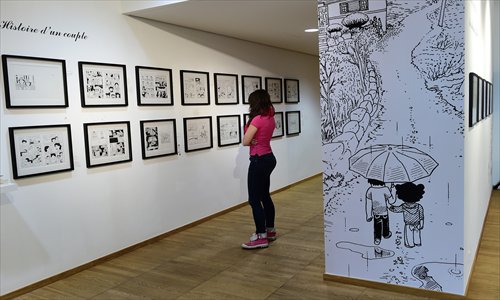HOME >> ARTS
S.Korean webtoons intrigue Belgian artists
Source:AFP Published: 2015-9-23 17:53:01

A visitor takes in the comics on display at The Belgian-Korean Comics Exhibition at the Korean Cultural Centre in Brussels on September 10. Photo: AFP
Belgium has long been a leading exponent of the traditional printed comic book, but a recent exhibition of South Korean "webtoons" has caused soul-searching in the land of Tintin and The Smurfs.The animated online comics, which are wildly popular in South Korea, have made some Belgian artists wonder whether they might be falling behind the times after a long period of global success.
The Belgian-Korean Comics Exhibition running until the end of October at the Korean Cultural Centre in Brussels offers a chance to compare the old and the new forms, with clips of webtoons being shown on screens.
Belgian comic artist Bernard Yslaire, whose works include the fanciful saga Sambre and the romantic series Bidouille et Violette, said South Korean readers were trend setters.
"That's (webtoons) all they read. It's very rare in Korea to publish comic books," says Yslaire, whose originals are on show at the exhibition.
"But that really grabs me. It's been 15 years that I have been trying to do the same thing. Everyone knows that Korea is the future, but we have the weight of the past," he added.
The center's director Chung Hae-tal says South Koreans are now massive consumers of webtoons.
"People are watching this everywhere in South Korea," he said.
Smartphones and tablets
Webtoons, sometimes known as web comics, are published online and are usually accessible for free on smartphones or tablets. They combine fixed and moving images, changing colors, special effects, sound and music.
And what works well in Seoul is now being exported, with some leading webtoons being published in English language versions.
Yet the traditional printed comic book became what the French-speaking academic world dubs the "Ninth art form" thanks in large part to Belgian artists like Herge, who produced Tintin and his canine companion Snowy, and Peyo, who gave the world The Smurfs, small blue creatures who live in mushroom-shaped houses in the forest.
And old-fashioned comic books remain enormously popular in Belgium. A comic book festival at the start of the month in Brussels drew up to 100,000 fans, enticed by the opportunity to meet artists or take part in creative workshops.
In South Korea, comic strips known as manhwa first surfaced in 1909 under the Japanese occupation with the aim of stirring people against imperialist rule, exhibition organizers said.
In the middle of the 1960s, people started flocking to "manhwabangs," libraries and private rooms where they could read manhwas. A decade later, the historic graphic novel dominated until a wave of Japanese manga comics invaded South Korea in the 1980s.
South Korean artists reacted by creating comics about sexuality, everyday violence and other adult themes and distributed their work on the Internet and eventually via smartphones.
Paving the way
Both Belgian authors and their South Korean counterparts say they find similar sources of inspiration, often from everyday life.
For example, the Brussels exhibition features pages from A Couple's Story, a graphic novel by South Korean author Hong Yeon-sik, about a comic artist who decides to leave the big city with his wife and settle in the countryside.
For French-speaking readers, this immediately brings to mind the comic book Return to Earth by Manu Larcenet and Jean-Yves Ferri - but the book is completely unknown in South Korea.
"Never heard of it," replied a smiling Hong.
At 33-years-old, his compatriot Ancco, who goes by one name, recalled having "discovered European authors in a museum for comic books" in South Korea, but admitted "not having real personal contacts" with her peers in Europe.
Ancco's accounts, which draw from her recollections of an "unhappy" youth in the suburbs of Seoul, has echoes of the story that young Flemish artist Delphine Frantzen tells in Madame Pipi, about a caretaker at public toilets who sees people from all walks of life come to meet the same basic need.
"In reading Belgian authors, I find similarities, both in the way the images and storylines are presented. Each one can reveal emotion," Ancco said after contemplating both Belgian and Korean comic strips.
Frantzen agreed even if she said she has "not yet tried to publish work on the Internet."
She added: "I still prefer a book to a screen, but the latter is the future. We have to find an audience for these kinds of things."
AFP
Newspaper headline: Comics of the future
Posted in: Comics